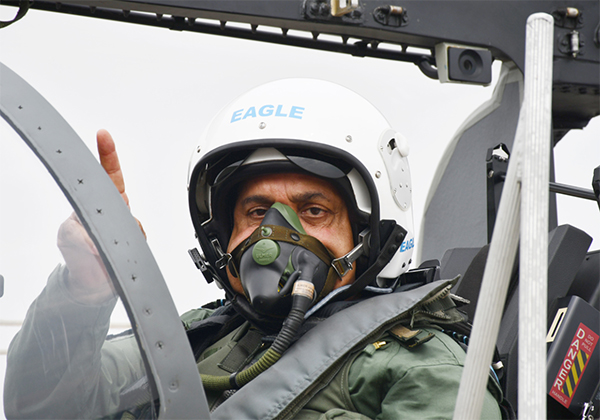The Indian Air Force (IAF) inducted its second ‘Tejas‘ Light Combat Aircraft (LCA) squadron – No 18 Squadron Flying Bullets – at Sulur air base in Tamil Nadu, on 27 May, marking the seriousness with which its air force takes the indigenous fighter jet and what’s in store for the ‘Make in India‘ programme.
Chief of Air Staff Air Chief Marshal RKS Bhadauria gave a thumbs-up to Tejas by flying a solo sortie — a feat never heard of for a newly inducted aircraft — just before handing over the aircraft to the squadron.
Tejas Mk1 is a fourth-generation single-engine, light-weight, highly agile, all-weather multi-role fighter aircraft capable of air-to-air refueling, thus making it a truly versatile platform.
The Flying Bullets would be the second IAF squadron to fly the Tejas. IAF had first inducted a Tejas Mk1 aircraft in its Initial Operational Clearance (IOC) configuration in July 2016 in to the No. 45 Squadron or ‘Flying Daggers‘ at Bengaluru and shifted the squadron to operate from Sulur to defend the nation’s peninsular region.
Chairman and Managing Director of Hindustan Aeronautics Limited (HAL) R. Madhavan and Defence Research and Development Organisation‘s Aeronautical Development Agency Director Dr Girish S. Deodhare were present. Madhavan presented the aircraft documents of the Tejas’ FOC variant to Air Chief Mshl RKS Bhadauria, who further handed them over to the No. 18 Squadron Commanding Officer Group Captain Manish Tolani. The Tejas Mk1 jets did a fly past along with a formation of Mi-17V5 helicopter and ‘Dhruv‘ Advanced Light Helicopter, and Antonov An-32 transport aircraft.
18 Squadron had been number-plated at Hasimara airbase in the east in 2016 after the MiG-27 aircraft that it was equipped with were decommissioned. The process of number plating involves reducing the Unit to just its number on paper, posting out all personnel, and redistributing its assets or phasing out of its assets. The unit henceforth exists only notionally, till resurrected again. It was then reactivated at Sulur to induct the Tejas Mk1 aircraft in its Final Operational Clearance (FOC) configuration.
The Sarangs (151 HU), Mi-17 V5 Knights (109 HU), AN-32 (33 Sqn) Soaring Storks and Tejas (45 Sqn) Flying Daggers are other residents of the historic AFS Sulur base. The base also houses a Radio and Maintenance Unit, a Transportable Radar Unit and a Garud commando unit. A Tejas Full Mission Simulator will soon be in place at the base which will further aid the new aircrew.
18 Squadron was raised at Ambala in April 1965 with the Folland Gnat aircraft. The squadron has won India’s highest war-time gallantry medal, Param Vir Chakra, during the 1971 India-Pakistan war through Flying Officer Nirmal Jit Singh Sekhon.
The squadron flew two HAL-made aircraft, including the Ajeet and the Soviet-origin MiG-27 ML aircraft from various air bases across India.
The IAF has so far ordered 40 Tejas aircraft and intends to procure a further 83. The deal has yet to be signed. Tejas is a single-engine, delta wing, lightweight multirole fighter with a payload capacity of 4,300 kg and a combat range of 500 km.
The IAF plans to induct 100 twin-engine Advanced Medium Combat Aircraft (AMCA) to form five squadrons.
India is also pursuing a foreign combat aircraft procurement programme under which 114 jets are to be bought at a cost of at least $15 billion. American Lockheed Martin Corporation‘s F-21, Boeing Company‘s F/A-18, French Dassault Aviation‘s Rafale, Swedish SAAB AB‘s Gripen, Airbus Defence and Space‘s Eurofighter Typhoon, Russian Aircraft Corporation MiG‘s MiG-35 and JSC Aviation Holding Company Sukhoi‘s Su-35 are competing for this deal.
In 2016, India signed an over $8-billion deal with France for 36 of the Rafale jets against 126 which were planned. The 114-jet future tender would be for making up the gap in the procurement of a 4+ generation combat aircraft through the now cancelled tender.


















